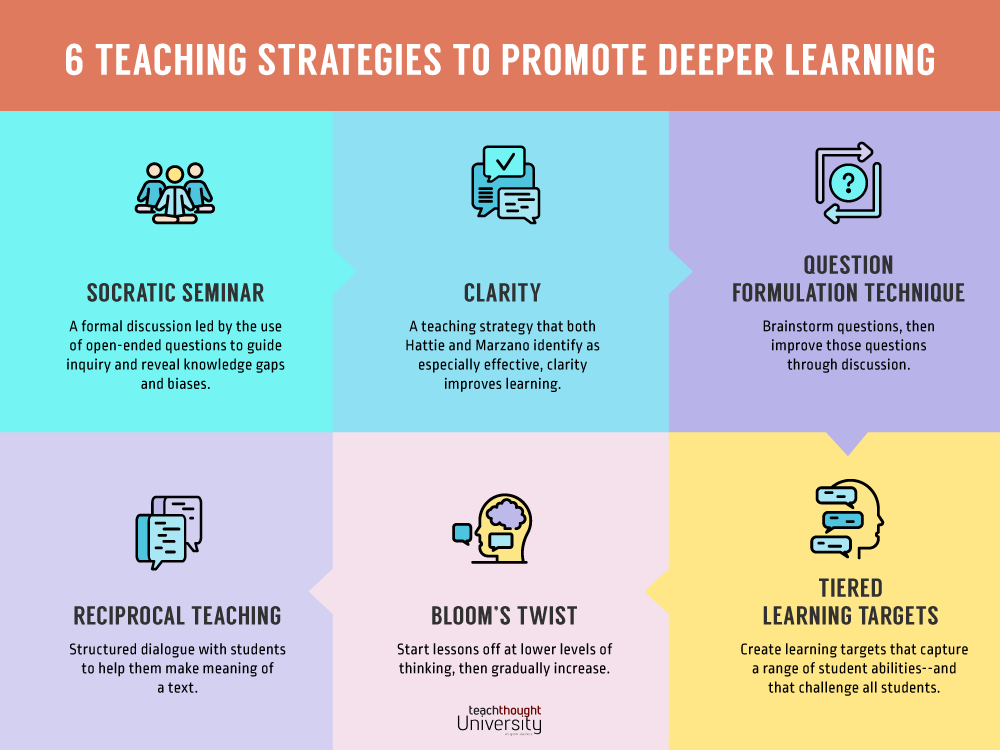Instructional Strategies That Challenge And Support Students
A teaching strategy is anything the teacher does or facilitates to help students learn.
So while formal teaching strategies like ‘Reciprocal Teaching’ and ‘Station Teaching’ are often thought of when considering these kinds of strategies, something as simple as ‘being clear,’ making eye contact, or even holding class outside could be considered a teaching strategy.
How can an instructional strategy both ‘challenge’ and ‘support’ students? Clarity supports students while allowing you and the student to pinpoint exactly what’s being learned, what the performance standards are, etc. Bloom’s Twists (based on Bloom’s Revised Taxonomy) can ‘make room for’ struggling students while challenging students who have mastered a topic at a lower level.
With that in mind, below I’ve gathered six of the more usable, flexible, and effective teaching strategies that might just make your job a little bit easier–and help your students grow just a little bit more.
You can pre-register for an upcoming course TeachThought University on these strategies that goes into more detail on each (while adding a few to the list).
Socratic Seminar
A formal discussion led by the use of open-ended questions to guide inquiry and reveal knowledge gaps and biases.
Socratic seminars are conducted by leading with a series of questions, so that the students must think critically about what they know and what they don’t. The process is highly effective for uncovering knowledge gaps and biases — students typically find out more than they ever thought was possible, and instructors gain insight into how well their students have retained the course material.
Clarity
A teaching strategy that both Hattie and Marzano identify as especially effective, clarity improves learning.
The ability to communicate is a vital skill for all kinds of leaders because it allows for proper conflict resolution and constructive dialog. When communication skills are poor, ideas flow in only one direction — from the leader down to the subordinates. Effective teachers know that they can learn something from their students as well, so they listen and respond to their colleagues. This means that teachers can’t simply ‘instruct’; they have to communicate clear learning goals through clear teaching, then listen closely to what students say–and sometimes notice what they don’t say, as well.
See also 12 Questions To Ask Your Students On The First Day Of School
Question Formulation Technique
Brainstorm questions, then improve those questions through discussion.
This teaching strategy doesn’t always look the same across classrooms, but generally the sequence is brainstorming questions, improving them through discussion and iteration.
See also 60 Critical Thinking Strategies For Learning
Tiered Learning Targets
Create learning targets that capture a range of student abilities–and that challenge all students.
This is something I use extensively as a teacher. The idea is to–in writing–provide an accessible ‘goal’ for each student based on the same learning standard or objective. The lowest tier may be for students to simply define a concept in their own words. A tier up maybe be to define it clearly and offer examples or alternatives. A tier higher may be to analyse or evaluate ‘it’ in specific contexts, and so on.
Bloom’s Twist
Start lessons off at lower levels of thinking, then gradually increase.
This is similar to tiered learning targets. The goal is to create an activity or lesson that begins at lower levels of thinking (using Bloom’s Taxonomy isn’t absolutely necessary), and ‘spirals’ up–or ‘twists’–by creating more complex goals or objectives. This can challenge students who are ‘ready for more’ while giving footing to students who may be struggling. Unlike tiered learning targets (or ‘objectives’–however you want to think about it), there can be a greater range of complexity between lower and higher levels of performance.
I can give more clarity or explanations of this in an upcoming webinar. You can pre-register here if you’d like.
Transfer Teaching
Design lessons that require transfer of understanding.
You can read more about categories of transfer for learning.
Reciprocal Teaching
Structured dialogue with students to help them make meaning of a text. You can read more about the definition of reciprocal teaching.
6 Teaching Strategies To Promote Deeper Learning

